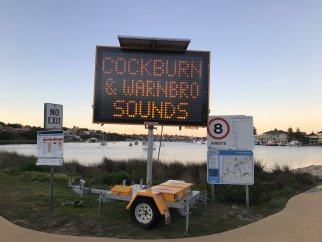Recfishwest has told the Commonwealth Government that important fish habitat and fishing grounds in Geographe Bay are strictly off limits for Offshore Wind Energy developments.
In February, the Commonwealth Government released proposals for public comment on a massive 7,674 square kilometre area to be earmarked for potential offshore wind farm development off Geographe Bay, with its closest point only 20km from shore off Cape Naturaliste and Bunbury, and 36km from Busselton.
Recfishwest Operations Manager Leyland Campbell said, “A significant proportion of this area contains critical fish habitat including seagrass meadows and large areas of coral and sponge gardens, which among other things support dhufish spawning aggregations, and includes popular fishing areas such as Naturaliste Reef and FAD grounds.”

To inform our submission, Recfishwest surveyed hundreds of local fishers who identified more than 400 important fishing areas within the proposed determination area. As expected, more than 95 per cent of recreational fishing activity within the proposed area occurs in water depths of less than 200 metres (see heat map below).
It is for these reasons that Recfishwest, on behalf of our cast of 700,000 fishers, has recommended the eastern boundary of the proposed area is moved west to beyond the 200-metre depth isobar. This would remove areas of critical habitat and important fishing grounds from consideration, therefore protecting fishing experiences.

Strong opposition
In addition, Recfishwest has criticised large gaps in the proposals and Commonwealth OWE policy that we have consistently been raising for months that remain unaddressed, including a clear position on potential exclusion zones being implemented around offshore wind infrastructure.
“Recfishwest will not support any offshore energy projects that impose access restrictions,” added Leyland. “As a matter of priority, offshore wind energy projects must provide clarity as to their impacts on fishing access and must avoid important habitats such as spawning areas, nursery grounds and popular fishing locations.”
What Recfishwest told the Commonwealth Government
Recfishwest’s recommendation to move the eastern boundary of the proposed determination west to the 200-metre isobar will:
- Reduce conflict with fishers and important fishing areas;
- Avoid all documented key ecological features;
- Avoid impacts on corals, seagrass, seaweed and sponge gardens;
- Avoid known dhufish aggregation areas
- Retain the area of greatest wind speed and consistency for offshore energy projects; and
- Is large enough to allow the development of an offshore wind industry that can deliver the Government’s desired 20GW of energy.
In addition, it is recommended the Government provides greater transparency about the known impacts of offshore wind industry and resolve inconsistencies in Government policy.
Recfishwest encourages all fishers to make a submission. Submissions on the proposed area can be made until 3 May 2024 through the Department of Climate Change, Energy, the Environment and Water (DCCEEW) consultation hub , which also has more information on the proposal.


